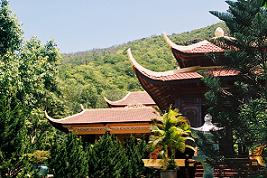ZENTOURISM FINDS ITS WAY IN VIETNAM
Jul 9, 2008
Hanoi, Vietnam – As Vietnam boasts a 2,000-year Buddhist history with more than 10 million followers, it is regarded as an ideal place for a new type of entertainment called zentourism or “du lich thien” in the Vietnamese language.

A zentourism programme provides tourists with visits to sites of Buddhist culture and a chance to join monks and nuns in their daily lives, making their mind calm through meditation and enjoying flower arrangement, tea, bonsai and culinary arts in the Buddhist style.
Ta Bich Ha, sales and marketing director of Asia Sun Travel, said as more and more people look for mindful practice in quiet countryside, zentourism will be one of the focal points in her company’s business strategy in the future.
“When the living conditions have been improved and the hustle and bustle of a modern life urges people to avoid stress, zentourism is indispensable,” Ha said.
Thai businessman Adul Udomlurtluk said more and more Thai people like zentourism programmes in Vietnam and this is a driving force for him to conduct research into this market.
Zentourism has been developing fast in Asia, particularly in Buddhist countries. This type of entertainment has begun to take shape in Vietnam along with the introduction of pilgrimages to Buddhist places.
The southern coastal province of Ba Ria-Vung Tau has planned to invest around 30 billion VND in a tourist area at the Chon Khong monastery. The site will accommodate areas for Yoga, meditation, calligraphy, a Buddhist museum and tea art performance.
There are around 120 pagodas available for zentourism in Vietnam, including popular names such as Dau in northern Bac Ninh Province; Ba Da and Tran Quoc in Hanoi; Truc Lam Tay Thien in northern Vinh Phuc Province; Tu Dam, Thien Mu and Tu Hieu in central Thua Thien-Hue Province; and Tu An, Giac Lam and Giac Vien in Ho Chi Minh City.
Source : VNA




